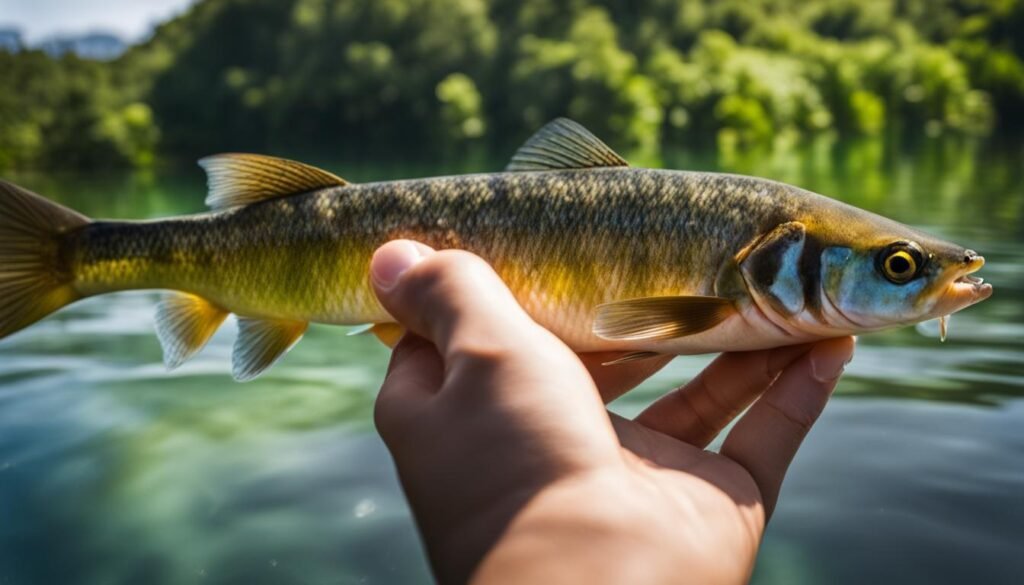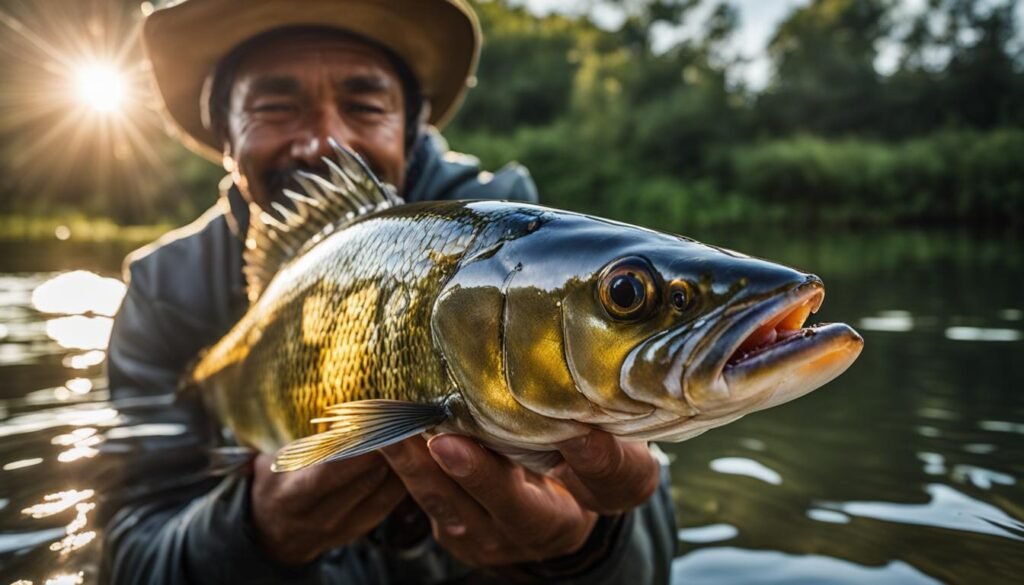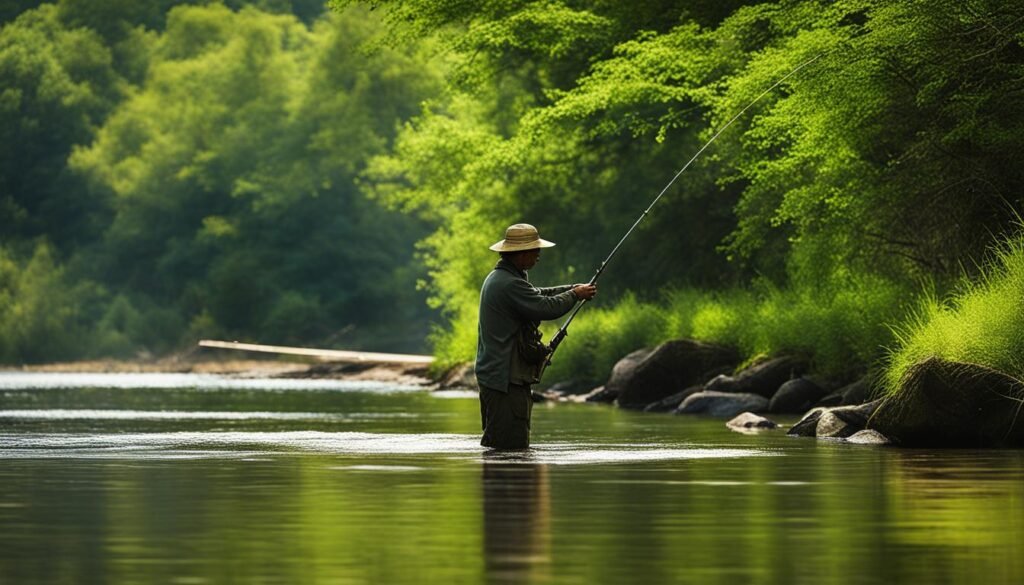Preserving fish populations is essential for the overall balance of our ecosystems. When you release native fish back into the water unharmed, you give them the opportunity to reproduce and contribute to the growth of their species. This promotes sustainable fishing practices and ensures that we can continue to experience the thrill of angling for years to come.
By understanding the importance of catch-and-release fishing, you become a responsible fisherman who values the preservation of fish populations. Together, we can make a difference in maintaining healthy fish populations and conserving our precious natural resources.
Techniques for Successful Catch and Release
Practicing catch and release fishing not only helps preserve fish populations but also ensures the sustainability of our fisheries. To make your catch and release efforts as successful as possible, here are some important techniques to keep in mind:
- Know the regulations: Familiarize yourself with the fishing regulations of the area you’re fishing in. These regulations may include specific guidelines on the type and size of fish that can be kept or released, as well as any special catch and release requirements.
- Use the right equipment: Using barbless hooks or hooks with crimped barbs can make hook removal easier and minimize injury to the fish. Landing nets with a soft, knotless mesh or rubber coating can help prevent damage to the fish’s delicate scales, fins, and protective mucus coating.
- Avoid exhausting the fish: Fight fish efficiently and avoid playing them to exhaustion. Extended fights can stress the fish and make their recovery more difficult. Use appropriate tackle and techniques to bring the fish in as quickly as possible.
- Handle fish carefully: Minimize stress and injury to the fish by handling them with wet hands or gloves. Avoid touching the fish with dry hands as it can remove their protective mucus. When handling the fish, support it properly and avoid squeezing tightly, which can cause internal injury.
Choosing the Right Gear for Catch and Release Fishing
When it comes to catch and release fishing, selecting the right gear is crucial for the well-being of the fish. By using the appropriate equipment, anglers can minimize stress and injury to the fish, increasing their chances of survival. Here are some key gear choices to consider:
Circle Hooks
Circle hooks are specially designed to reduce the chances of gut hooking a fish. These hooks have a circular shape and a point that turns inwards, making it less likely to catch in the fish’s throat or stomach. By using circle hooks, you can improve hook removal and minimize harm to the fish.
Barbless Hooks
Barbless hooks are another excellent option for catch and release fishing. These hooks do not have the small barb that traditional hooks have, making it easier to remove them from the fish’s mouth. Barbless hooks greatly reduce the risk of causing injury to the fish during hook removal.
Rubber Landing Nets
When landing a fish, it’s important to use a net that won’t harm the fish’s delicate scales, fins, or eyes. Rubber landing nets are a great choice as they are soft and gentle on the fish. These nets are also less likely to become entangled in the fish’s fins, minimizing the risk of injury. Make sure to wet the net before use to prevent the fish’s protective mucus from being removed.
| Gear | Description |
|---|---|
| Circle Hooks | Specially designed to reduce gut hooking and improve hook removal. |
| Barbless Hooks | Easier to remove from the fish’s mouth, reducing the risk of injury. |
| Rubber Landing Nets | Soft and gentle on the fish, minimizing the risk of harm. |
Handling Fish with Care

Properly handling fish during catch and release is crucial for their survival. By following these guidelines, you can ensure minimal stress and injury to the fish you release back into the water.
Wet Hands or Gloves
When handling fish, it’s important to keep their protective mucus intact. Wet your hands or wear gloves to prevent removing this crucial layer of defense. The mucus helps protect fish from infections and parasites, ensuring their overall well-being.
Proper Fish Support
To avoid causing unnecessary harm to the fish, support it properly while handling. Never squeeze or put excessive pressure on the fish, as this can damage internal organs and muscle tissue. Instead, cradle the fish gently and ensure it is fully supported. This will help minimize injury and increase the fish’s chances of survival.
| Do: | Don’t: |
|---|---|
| – Handle the fish with wet hands or gloves | – Touch or hold the fish by the gills |
| – Cradle the fish gently | – Squeeze or put excessive pressure on the fish |
| – Support the fish properly | – Remove the fish from the water unnecessarily |
Removing Hooks Safely
When practicing catch and release fishing, it is essential to remove hooks safely to minimize harm to the fish. The use of needle-nosed pliers or a dehooker is recommended for quick and efficient hook removal. These tools allow for a firm grip on the hook, making it easier to extract without causing unnecessary injury to the fish. Remember to work quickly and calmly to minimize stress on the fish during the removal process.
If a fish is deeply hooked or the hook cannot be easily removed, it is best to cut the line as close to the hook as possible. This approach minimizes harm to the fish and increases its chances of survival. Leaving a deeply hooked fish with a portion of the hook in place may sound counterintuitive, but it is often the best course of action to prevent further injury during attempts to remove the hook.
Your Guide to Photographing Fish Responsibly

When you practice catch and release fishing, capturing the moment through photography can be a rewarding experience. However, it’s important to approach fish photography with care to ensure the well-being of the fish. By preplanning your photograph, using proper fish grip techniques, and minimizing handling time, you can capture stunning images while keeping the fish safe.
Before snapping a photo, consider the following tips to preplan your shot. Keep the fish wet and calm until you’re ready to take the picture. This helps maintain the fish’s moisture and reduces stress. Choose a suitable background and lighting to enhance the beauty of the fish. By taking these steps, you can create visually appealing photographs while minimizing any potential harm to the fish.
When holding the fish for a photograph, it’s crucial to use a proper fish grip. Hold the fish firmly by the tail, while supporting its belly with your other hand. This grip ensures that the fish is secure and prevents it from wriggling or slipping. Avoid touching the sensitive gill area to prevent any damage. Remember, a gentle and controlled hold is key to keeping the fish comfortable and safe.
Proper Fish Grip Techniques:
- Hold the fish firmly but gently by the tail
- Support the fish’s belly with your other hand
- Avoid touching the gill area
- Keep the fish in a horizontal position
Releasing Fish Safely
Ensuring the safe release of fish during catch and release is essential for their survival. By following proper techniques, you can help maximize the fish’s chances of recovery and reduce any stress or harm caused during the process.
After catching a fish, it is important to let it fully recover before releasing it. Holding the fish underwater or securing it in a landing net can help facilitate its ventilation and regain its strength. This allows the fish to recover and swim away on its own, ensuring its well-being.
If a fish has difficulty recovering, you can try facing it into the current to help it “catch its breath.” This technique helps oxygenate the fish’s gills and facilitate its recovery. In fast-moving water, it is recommended to move the fish to calmer water where it can recover more effectively.
| Releasing Fish Safely | Tips |
|---|---|
| Fully recover the fish | Hold it underwater or in a landing net until it regains its strength |
| Facilitate recovery | Face the fish into the current to help it “catch its breath” |
| Move to calmer water | Transfer the fish to an area with less water flow for better recovery |
By following proper fish releasing techniques, you contribute to the overall success of catch and release fishing. It ensures that the fish have the best chance of survival and allows them to continue supporting healthy fish populations. Remember to always prioritize the well-being of the fish and promote responsible angling practices.
Releasing Fish Caught in Deep Water
When it comes to catch and release fishing, releasing fish caught in deep water requires special consideration. The rapid ascent from the depths can cause barotrauma, a condition where gases in the fish’s body expand, making it difficult for them to swim back down. To ensure the survival of these fish, anglers can employ various recompression tools.
Recompression Tools for Releasing Fish
Recompression tools are designed to help fish recover from barotrauma and safely return to their natural habitat. These tools include:
- Descender devices: Descender devices allow for controlled descents of fish back to the appropriate depth. These devices attach to the fish’s mouth and release them at a controlled rate, allowing them to regain their equilibrium and swim away.
- Release weights: Release weights can be attached to the fish’s mouth or fin to help them quickly return to depth. These weights aid in counteracting the effects of barotrauma and assist the fish in resuming normal swimming behavior.
- Release baskets: Release baskets are large floating devices that allow fish to recover before being released. The fish can be placed in the basket while still in the water, and the basket can then be gently lowered back down to the appropriate depth.
By utilizing these recompression tools, anglers can greatly increase the chances of survival for fish caught in deep water, ensuring their continued contribution to healthy fish populations.
| Recompression Tools | Description |
|---|---|
| Descender devices | Attach to the fish’s mouth and allow controlled descent back to depth |
| Release weights | Attach to the fish’s mouth or fin to aid in returning to depth |
| Release baskets | Large floating devices that allow fish to recover before being released |
Catch and Release Fishing as a Conservation Tool
Catch and release fishing plays a vital role in fishery management and the conservation of healthy fish populations. By practicing catch and release, anglers contribute to the preservation and sustainability of fishery resources, ensuring that future generations can continue to enjoy the angling experience. This responsible approach to fishing helps maintain the balance of ecosystems and promotes the responsible stewardship of natural resources.
Through catch and release fishing, anglers actively participate in managing fish populations. By releasing fish instead of keeping them, they allow younger fish to grow into adulthood and contribute to the overall health of fish populations. This practice helps maintain the biodiversity of aquatic environments and ensures the long-term sustainability of fish species.
Fishery management relies on various strategies to ensure the health and abundance of fish populations. Catch and release fishing complements these efforts by conserving fish populations and promoting sustainable practices. By implementing proper catch and release techniques, such as using appropriate gear, handling fish with care, and ensuring their safe release, anglers actively contribute to the maintenance of healthy fish populations and the preservation of our natural ecosystems.
| Benefits of Catch and Release Fishing | Fishery Management Strategies |
|---|---|
|
|
The Impact of Catch and Release Fishing on Fish Species
Catch and release fishing has a positive impact on fish species by allowing them to reproduce and contribute to population growth. When anglers release fish back into their natural habitat, they provide opportunities for the fish to spawn and increase their numbers. By practicing catch and release fishing, we can help maintain healthy fish populations and ensure the long-term sustainability of fish species. This conservation effort plays a crucial role in fostering the preservation of biodiversity in aquatic environments.
Catch and release fishing is particularly beneficial for fish reproduction. When fish are caught and promptly released, they can continue their natural life cycle, including spawning and producing offspring. By allowing fish to reproduce, catch and release fishing helps to replenish fish populations and contribute to their growth. This ensures that future generations can enjoy the abundance of fish in their natural habitats.
In addition to promoting fish reproduction, catch and release fishing also contributes to overall fish population growth. By releasing fish instead of keeping them, we are giving them the opportunity to grow and contribute to the population. Younger fish can mature and reach reproductive age, ensuring a continuous cycle of growth and sustainability. This practice helps maintain a balanced ecosystem and supports the overall health of fish populations in our waters.
Overall, catch and release fishing has a significant positive impact on fish species. By allowing fish to reproduce and contribute to population growth, we are playing an active role in conserving fishery resources. This sustainable approach to fishing promotes responsible stewardship of natural resources and ensures that future generations can continue to enjoy the beauty and abundance of fish in our waters.
Final Thoughts
If you want to contribute to the preservation of fish populations, improve future angling opportunities, and be a responsible fisherman, catch and release fishing is the way to go. By practicing catch and release, you play an important role in the sustainability of fishery resources and the conservation of fish species.
Catch and release fishing offers numerous benefits. Not only does it allow fish populations to thrive and reproduce, but it also ensures that future generations can enjoy the thrill of angling. By releasing fish back into their natural habitat, you are promoting the responsible management of fish species and fostering the preservation of biodiversity in our aquatic environments.
As a responsible fisherman, you understand the importance of catch and release techniques. By following proper handling and release practices, you can minimize stress and injury to the fish, increasing their chances of survival. Your commitment to catch and release fishing helps maintain healthy fish populations and provides future angling opportunities for you and other fishing enthusiasts.


Pingback: Why Livewells are Essential for Successful Catch and Release Fishing: Ensuring Fish Health and Survival